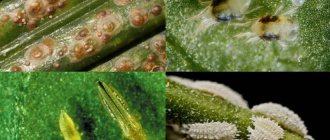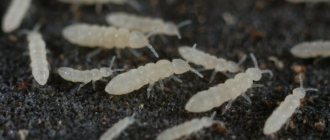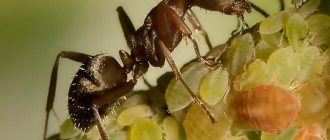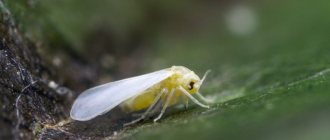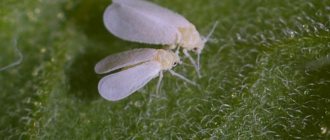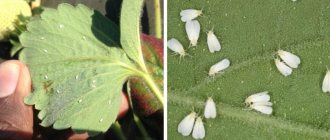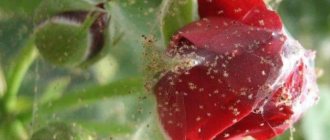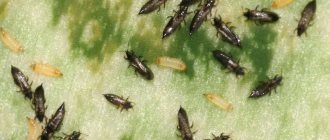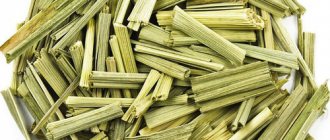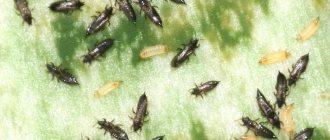A small whitefly butterfly, the size of which is no more than 2.5 mm, can, if measures are not taken in time, destroy more than one indoor plant. The female, hiding under a leaf, lays up to 300 eggs per month, and the larvae, which appear every few days, suck the juices from the leaves and tender stems. After two weeks, the larva will emerge from the cocoon, turn into a butterfly and begin laying eggs.
If you do not interrupt the cycle, the insect will suck out all the juices and the plant will gradually dry out. Fighting the pest is not easy - drugs that kill the adult do not affect the larvae hidden in the cocoon. Success depends on how quickly the butterfly is discovered.
Description and types of whitefly
It is not so easy to see whiteflies - they have tiny sizes, from 1.3. mm. up to 2.5. mm. depending on gender. They are necessarily white or predominantly white in color - only this feature makes them noticeable on the soil of the pot and the flower itself; they resemble moths in appearance.
REFERENCE! Adult whiteflies cause a lot of harm - for example, they spread phytoviruses. But the larvae of these insects are much more dangerous for plants - they eat a lot and quickly, and also securely attach themselves throughout the plant, destroying it.
It is easier to detect whiteflies in motion - having settled on a flower, they actively move around it and hide when a threat appears. If you see an insect but are not sure, look at photos of whiteflies on houseplants from other gardeners.
Tobacco or cotton
The main danger of these insects is the transfer of viruses to a variety of plants - not a single flower can be insured against this. The most common type.
Greenhouse or greenhouse
It is possible that your pests are of this particular species - it is the second most common. These insects breed all year round and can easily be carried into your apartment by the wind.
Asian or citrus
Not very common, it can mainly be found in the Caucasus or the Black Sea coast.
Most likely you will find representatives of the first two species on your plants. They reproduce quickly, and adults run away from danger - which is why it is necessary to destroy them as quickly as possible from the moment of discovery.
What kind of insect is this
There are about 200 species of whiteflies in nature. Previously, these insects lived only in warm regions. Today they are found everywhere, parasitizing vegetables, greenhouse and indoor crops. They are miniature butterflies 1.3-3 mm long. The body and wings are covered with a whitish waxy coating. The female lays about 300 eggs per month.
The whitefly develops from the egg stage to the adult in several cycles (on average 1.5-3 months):
- Laying eggs on the underside of leaves.
- Brown or black caterpillars emerge from eggs. They are localized on the lower part of the leaves and feed on plant sap. The caterpillar stage lasts 7-11 days.
- Caterpillars turn into motionless larvae (nymphs).
- Over the course of 1-2 weeks, the nymphs increase in size, remaining motionless.
- The larva develops into a black oval pupa.
- An adult butterfly hatches from the pupa.
The most common types of whiteflies:
- greenhouse (greenhouse);
- tobacco;
- citrus;
- strawberry
Favorable conditions for the development of the pest are warm air and high humidity. Therefore, whiteflies often parasitize indoor and greenhouse plants.
Whitefly harm
The greatest damage to plants is caused by larvae. They feed on the sap of stems and leaves. While the larvae are forming into butterflies, they can damage up to half the plant.
Adult whiteflies leave their metabolic products on the surface of the leaves. Over time, the affected areas begin to deteriorate and the plant gradually dies. Insects can also carry viral infections. As a result of infection, the stems are deformed, the leaves curl, spots and yellowness appear. The plant stops growing.
Causes of pests
You don’t need to do anything specific for whiteflies to appear - these insects move with the wind, so they can settle completely by accident. Most often this happens in spring and summer, when the air is warm and the windows are open.
These parasites also infect the soil with their larvae - the eggs easily tolerate cold and begin to actively develop only in suitable conditions. To avoid this option, buy flower soil in a safe, sealed package, or take any soil, but process it at high temperatures.
How to detect
Whiteflies on indoor plants are noticeable due to their white color and chaotic movement. There can be a large number of adult insects on one flower at the same time, so you will most likely notice them quickly.
Most often, the pest hides under the leaves of the plant (if there are any - and the whitefly prefers deciduous species). Lift one leaf and shake it a little - the adults will scatter and you can see the small spherical capsules of the larvae. They are covered with a dense layer of waxy substance that protects them from almost any external influence.
Drosophila
They are typical for indoor plants, as tiny dark flies are attracted to the smell of rotting food. They are dangerous because they can spread small pests and infections.
They appear in flower pots where the soil is damp and roots or fallen leaves have already begun to rot. It is also possible to transfer these flies through garden soil contaminated with their eggs.
Therefore, in order to avoid fruit flies getting into the flowers, it is necessary to replant plants only in disinfected soil or in ready-made nutrient substrates purchased in specialized stores. Watering the plants should be moderate, and faded flowers and missing leaves should be removed.
Signs of plant infection
You don't have to look out for insects to understand that something is wrong with the plant. There are several signs of infection, having noticed which you can definitely start thinking about how to treat your plants against whiteflies.
The main signs of the appearance of parasites:
- The plant itself fades - it begins to wither and turn yellow for no objective reason. This happens because adult insects introduce viruses and leave honeydew (more on that below), and the larvae feed abundantly on the juices of the flower.
- Honeydew or honeydew appears on the leaves and stem - a sticky silvery-white coating secreted by adult insects. If there are such traces, then the pests have already firmly established themselves on the plant.
- White, and then black, spots on the leaves and stems from sooty fungus. This sign suggests that saving the plant will no longer be easy. Sooty fungus appears shortly after honeydew - their development is interconnected.
If you notice any of these signs, look for insects or larvae. As soon as your fears are confirmed, try to figure out what phase of reproduction the pests are in - this is critically important for controlling whiteflies on plants.
IMPORTANT! Be sure to isolate the plant as soon as you notice signs of infection - this is a necessary measure so that other flowers are not harmed. Whiteflies quickly invade neighboring pots as soon as the population becomes too large.
Larvae and adults require different measures for eradication - keep this in mind. First of all, try to destroy all adult insects - they multiply very quickly, and then tackle the larvae.
Biological methods
Chemical preparations against whiteflies are gradually losing their relevance. Biological methods of control are being replaced. Examples:
- Placing encarsia pupae in greenhouses. The female parasite lays eggs in the bodies of whitefly larvae, which leads to death. Encarsia pupae are launched 2 weeks before planting. Macrolophus bug. Tobacco and greenhouse whiteflies are destroyed. These bugs are released before the active development of the pest. Against whiteflies, 1 insect per 1 m² is enough.
The colonization of greenhouses and greenhouses with entomophages is characterized by an efficiency of up to 99%. Biological enemies are especially useful for pests on tomatoes. Cucumbers contain hairs on the surface, which prevents entomophages.
On a note! Common natural enemies of whiteflies are the lacewing fly, ladybug, and ichneumon beetle.
Chemical treatment
To successfully combat whiteflies on indoor plants, reliable chemicals have long been invented - all you have to do is select and apply them correctly. Many gardeners are afraid that the chemicals will damage the plant, but all insecticides that are used to kill whiteflies are designed to have minimal impact on house flowers and other cultivated plants.
Most of the products that will help you kill these parasites are long-acting - this is necessary, since some whiteflies can survive after treatment, and this is enough to restore the colony. Having chosen a drug, use it exactly according to the instructions, observing the dosage - you need to destroy the entire population at one time.
Aktara is considered the best insecticide against whitefly.
This drug is used most often - flower growers choose it due to its long-lasting action and prevention of re-infection for almost a month. It has a complex effect - after watering, it impregnates the plant and its juices, which the parasites feed on, with a deadly poison for them. The entire colony dies within a week or 10 days - you don't need to do anything for this.
How to prevent and protect garden plantings from re-infection?
To get rid of midges forever, to save trees from falling leaves and crop loss, it is necessary to periodically prevent diseases and relapses. After processing the garden, as a rule, the whiteflies return to new plantings, from where “no one drove them away.”
- Disinfection should be carried out several times a year. Bleach will help protect tree trunks and crowns.
- Cold kills pests. It is enough to lower the temperature in the greenhouse, and the whitefly will die.
- After harvesting, you need to burn the remaining leaves.
- For prevention, you need to quarantine flowers - do not bring them into the house, do not plant healthy plants near crops.
Other effective drugs
Spark
An insecticide identical in action to Aktara. Valid for 25 days.
Confidor and its analogues
Not only kills the main colony after watering, but also has a contact effect (only against adult insects).
Akarin
Contact and food poison for whiteflies. You should not relax immediately after treatment - you need to monitor the plant for some more time to make sure that the whitefly has died as a whole in the colony. Relapses often occur, to which it is worth responding just as quickly.
Weevils
Small flying bugs like to nibble on leaves, like Colorado potato beetles. And their larvae destroy the roots and tubers of plants. It is better to collect bugs by hand early in the morning.
Spraying with systemic insecticides such as “Fufan” and “Inta-vir” helps against them and their larvae. An alternative method is four-time ground watering with Aktara solution (one gram per bucket at weekly intervals) or one-time foliar treatment with this drug at a dose increased by 8 times.
An effective measure to combat larvae is to replant plants in fresh soil. Before this, you should disinfect the roots of damaged plants with a weak solution of potassium permanganate for half an hour.
Non-chemical plant treatment
If you don’t have a chemical on hand, and you need to start understanding how to deal with whiteflies on indoor plants now, you can try methods that do not involve insecticides.
First, try to clean the plant mechanically - take it out into the open air and carefully shake off the adult insects, then take the pot away. Of course, you won’t be able to kill the entire colony this way, but you will improve the situation. Do not try to remove the larval cocoons - they are securely attached to the leaf, so you will only scratch the plant.
Another option is glue traps. Whiteflies are very light insects, so even a small layer of glue will be fatal to them. Traps can be purchased or made; bright yellow is recommended. You don't need to do anything - just place a few in and around the pot, the pests will stick to it on their own.
Fungus gnat (sciarid)
The insect is small in size (1.5 mm), similar to a midge, having an oblong body with wings. The mosquito itself is not very dangerous. The main pests are sciarid larvae (white, worm-like), which can infect the entire root system of the plant, after which it dies. For prevention, you need to avoid over-moistening the soil. This can prevent insects from laying eggs.
Of course, this is not the entire list of insect pests. The most common ones found at home are highlighted.
These flying pests of indoor plants reach sizes of up to 0.5 centimeters. Adult mosquitoes lay tiny eggs in the roots of flowers. The larvae that emerge from them eat the roots, which is why pets often die.
Insect larvae are removed using the drugs “Decis”, “Karbofos”, “Inta-vir”. Moreover, one-time treatment is often ineffective. Fly repellents help against adult pests: special Velcro, Raptor, Fumitox, and if they are ineffective, then Dichlorvos. As a rule, complex measures are used repeatedly.
The best folk remedies for whiteflies
There are also effective folk remedies - with them, the fight against whiteflies is possible even on indoor plants with increased sensitivity to treatment. The first place to start is with processing and cleaning. Drive away as many insects as you can and start removing all the affected parts of the plant - leaves and shoots in the fungus. Remove honeydew too.
The most popular folk methods.
Garlic infusion
You need three cloves of garlic and a liter of boiling water - mix it and leave it in a dark place for a day. Spray the plant well with this liquid from a spray bottle, without watering it under any circumstances.
Soap solution
Prepare it carefully - you only need one tablespoon of grated soap and 6 liters of water. Reduce the proportions to the required level and spray; watering is also strictly forbidden.
Dichlorvos
Do not spray the plant directly, it is very harmful. Soak a piece of cotton wool in the chemical, place it in the pot and place the flower in a bag or bag that can be tied. After tying it, leave it for five hours.
If this does not help, it is recommended to return to insecticides - it is better to risk the health of the plant a little (although the likelihood of this is exaggerated) than to risk losing it completely.
Processing rules
Depending on the substance, one of the treatment methods is selected - watering or spraying. Most insecticides work in the first way - in order to saturate the plant and kill numerous larvae, folk remedies, on the contrary, usually require spraying.
Often these measures intersect with each other in a variety of processing methods. Experienced gardeners advise not to neglect spraying in any case.
Prevention measures
You won’t be able to completely protect your flowers from the possible appearance of whiteflies - but you can do everything possible. The best thing you can do to keep your houseplants safe is to install mosquito nets.
IMPORTANT! It is highly likely that you will get whiteflies if you grow tomatoes at home - these pests love them very much. Try to keep such seedlings away from flowers.
It is not worth treating plants with chemicals prophylactically - this can be harmful. Try to inspect the flowers more often. As soon as you notice several individuals, be sure to kill them - this way you can prevent the emergence of a colony.
Preventive measures
To prevent the appearance and spread of whiteflies, you must adhere to the following recommendations:
- Do not plant bushes close to each other;
- Plantings must be ventilated to avoid air stagnation;
- Adjust humidity:
- Use biostimulants that strengthen the immunity of flowers;
- Fertilize the soil.
